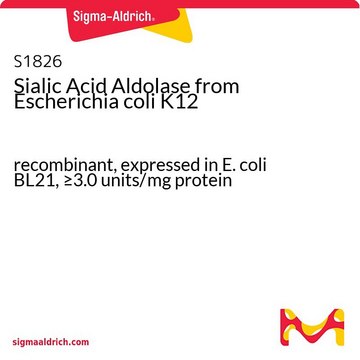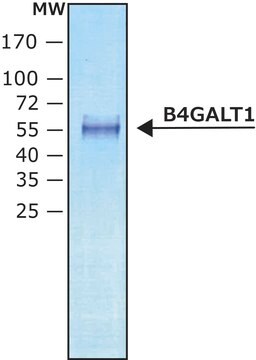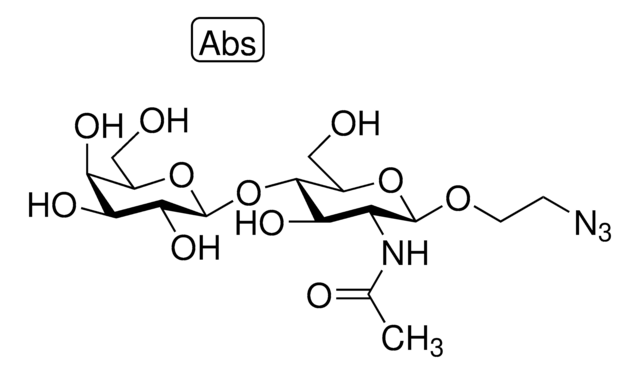C1999
CMP-Sialic Acid Synthetase from Neisseria meningitidis group B
recombinant, expressed in E. coli BL21, ≥10 units/mg protein
Synonyme(s) :
CTP: N-Acylneuraminate cytidylyltransferase
Se connecterpour consulter vos tarifs contractuels et ceux de votre entreprise/organisme
About This Item
Numéro MDL:
Code UNSPSC :
12352204
Nomenclature NACRES :
NA.54
Produits recommandés
Produit recombinant
expressed in E. coli BL21
Niveau de qualité
Forme
lyophilized solid
Activité spécifique
≥10 units/mg protein
Poids mol.
26.0 kDa
Conditions d'expédition
dry ice
Température de stockage
−20°C
Vous recherchez des produits similaires ? Visite Guide de comparaison des produits
Description générale
Cytidine monophosphate (CMP)-Sialic Acid Synthetase from Neisseria meningitidis group B is encoded in neuA gene. The protein has a molecular weight of 24.8 kDa.
Application
The enzyme has been utilized to synthesize CMP-sialic acid and its derivatives.
Actions biochimiques/physiologiques
Cytidine monophosphate (CMP)-sialic acid synthetase catalyses the conversion of N?acetylneuraminic acid (NeuNAc) to CMP-NeuNAc. CMP-sialic acid synthetase has globular α/β domain and is categorised under αβα three-layered sandwich fold. The dimerization domain aids the interaction between the monomers. It also has mononucleotide binding and NeuAc binding pocket. Mg2+ is essential for the catalytic functionality of CMP-sialic acid synthetase.
Définition de l'unité
One unit will catalyze the formation of 1 μmol CMP-Neu-5-Ac from Neu-5-Ac and CTP per minute at 37 °C at pH 8.0.
Forme physique
Supplied as a lyophilized powder containing Tris-HCl and NaCl.
Remarque sur l'analyse
Enzymatic activity assays are performed in Tris-HCl buffer (100 mM, pH 8.5) containing Neu-5-Ac (1 mM) and CTP (1 mM) at 37 °C for 30 min and analyzed using capillary electrophoresis with a UV detector (200 nm).
Code de la classe de stockage
11 - Combustible Solids
Classe de danger pour l'eau (WGK)
WGK 3
Point d'éclair (°F)
Not applicable
Point d'éclair (°C)
Not applicable
Faites votre choix parmi les versions les plus récentes :
Déjà en possession de ce produit ?
Retrouvez la documentation relative aux produits que vous avez récemment achetés dans la Bibliothèque de documents.
Les clients ont également consulté
Molecular cloning and analysis of genes for sialic acid synthesis in Neisseria meningitidis group B and purification of the meningococcal CMP-NeuNAc synthetase enzyme.
Ganguli S, et al.
Journal of Bacteriology, 176(15), 4583-4589 (1994)
Thomas Haselhorst et al.
Biochemical and biophysical research communications, 359(4), 866-870 (2007-06-19)
We report an easy and direct application of 'Saturation Transfer Double Difference' (STDD) NMR spectroscopy to identify ligands that bind to a Sepharose-immobilised target protein. The model protein, cytidine 5'-monophosphate sialic acid (CMP-Sia) synthetase, was expressed as a Strep-Tag II
Structure of a sialic acid-activating synthetase, CMP-acylneuraminate synthetase in the presence and absence of CDP
Mosimann S, et al.
The Journal of biological chemistry, 276(11), 8190-8196 (2001)
Rahman M Mizanur et al.
Applied microbiology and biotechnology, 76(4), 827-834 (2007-07-03)
In this study, we report the cloning, recombinant expression, and biochemical characterization of a heat-stable CMP-N-acylneuraminic acid (NeuAc) synthetase from Clostridium thermocellum ATCC 27405. A high throughput electrospray ionization mass spectrometry (ESI-MS)-based assay demonstrates that the enzyme has an absolute
Rahman M Mizanur et al.
Applied microbiology and biotechnology, 80(5), 757-765 (2008-08-22)
Sialic acids are abundant nine-carbon sugars expressed terminally on glycoconjugates of eukaryotic cells and are crucial for a variety of cell biological functions such as cell-cell adhesion, intracellular signaling, and in regulation of glycoproteins stability. In bacteria, N-acetylneuraminic acid (Neu5Ac)
Notre équipe de scientifiques dispose d'une expérience dans tous les secteurs de la recherche, notamment en sciences de la vie, science des matériaux, synthèse chimique, chromatographie, analyse et dans de nombreux autres domaines..
Contacter notre Service technique













